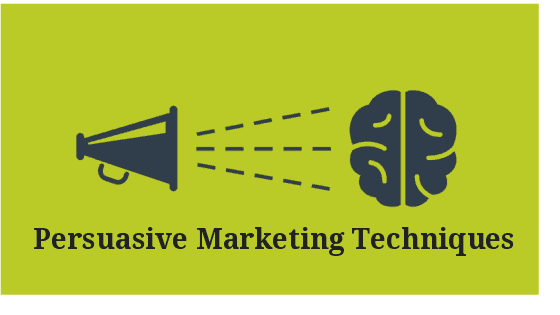Marketers have to write so many different documents. You will write campaign content in landing pages, emails, social posts, product descriptions.
All of them have one goal – to sell your stuff. Yet, despite your best efforts to keep it engaging and focused on benefits, your copy fails to convert.
There are some campaigns that are so irresistible; they drive prospects seamlessly from your various online assets all the way to click on the CTA and makes them likely to buy.
What’s the difference between such high-converting content and your pages?
The answer is: they apply principles of persuasive marketing or persuasion marketing and these persuasive techniques do their work of converting for them.
Table of Contents
Why use Persuasive Marketing Techniques?
If you are thinking: “How does persuasive marketing differ from copywriting?” – you are not alone!
Persuasive marketing or persuasion marketing is a general term for a lot of techniques in marketing.
These persuasion marketing techniques can be used by anyone – marketing manager, advertising account manager, etc.
Even your web designer has to build web pages with methods of persuasion marketing in mind. Persuasion marketing incorporates persuasion strategies applied by everyone in your marketing department.
Copywriting is a more formal discipline that uses words to apply these persuasion marketing techniques.
Copywriters rely on buyer’s psychology and use those as triggers all the time as a part of persuasion marketing and render readers likely to buy.
Anybody can apply persuasion marketing techniques in various ways (other than words), copywriters are your wordsmiths who figure out ways to make your landing pages into your online salesmen.
So, if you have marketing and MarCom executives in your network, share this article with them. If you are one of them, read on!
Persuasive Techniques Definition
To understand what are persuasive techniques, we must understand what is persuasion.
Persuasion is a literary device that writers use to convince and influence their audience and make them likely to buy your products/services. The objective of persuasion can be
- to bring the audience on the same page as the writer (convincing for an opinion)
- To get the audience to perform a certain action (convincing for an action)
Persuasion can be applied in speaking and writing. The writer or speaker uses his own credibility, logic, or emotions to convince a user to believe in their opinion or take an action.
This reminds us of a strategy called neuromarketing. Check out this video for a quick overview:
Persuasion in Marketing
Persuasion marketing uses lessons from human psychology to build a repertoire of techniques for marketing products or services.
During the promotion phase, these persuasion marketing techniques are applied to different aspects – website design, content for social media posts, landing pages, and product descriptions.
Examples of persuasion techniques
Here is an example of a persuasion marketing technique used for a call-to-action (CTA) on a page by Spotify.

Here, Spotify uses visual cues with an appealing image to put the audience in a specific mood. The text attempts to convince of the benefits of Spotify as a product.
Convincing about benefits (not features) is central to persuasion marketing. Finally, the CTA button entices the user to click it by adding the word “free”.
Persuasion marketing finds a big place in eCommerce because the sales there are transactional in nature.
On this page below, Lush Cosmetics uses lighting effects on a high-definition photo to bring out the rustic charm that perfumes have.
This image instantly puts the reader in a “classic” mindset. By using a text that associates their fragrances with personality, they appeal to the reader’s emotions.
Finally, the CTA capitalizes on the text and the image by inviting the reader to view their collection. This is a classic example of persuasion marketing.
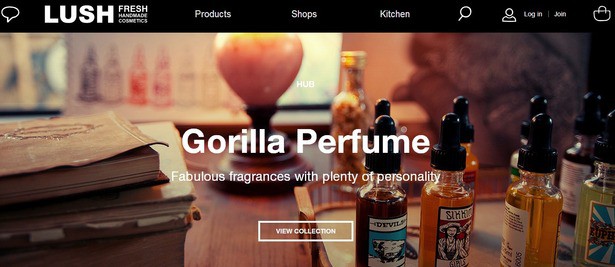
Types of Persuasion – Common Persuasive Methods
Understanding the different types of persuasion marketing techniques helps choose the right kind of persuasion to apply in any specific situation.
These are types of persuasion, that sets the base for a list of persuasion marketing techniques explained later on in the article. Even the persuasive techniques in advertising rely on these basic persuasive methods.
1. Ethos
To convince by using the authority and credentials of the speaker (or the selling company) is an application of Ethos.
This persuasion marketing technique is often used to amplify the correctness of the message after the user has already accepted the message and may be likely to buy.
2. Pathos
You can apply Pathos to use the user’s own emotions to convince them further. The awareness of basic human needs is extremely crucial for applying Ethos.
You can refer to Maslow’s Hierarchy of Needs to understand which psychological human needs your product/service fulfills.
3. Logos
You can apply logos by using facts (no hard evidence) to convince the user that their choice is the best choice.
Logos is more about helping users filter out the choices in a way that your product/service becomes the default choice.
4. Statistics

When applying Statistics, we use hard data from studies conducted by reputed organizations or individuals to convince users that your product/service holds the most merit in the market.
Here, we acknowledge that the user may not be fully confident of his/her own choice. So we present them with hard data to help them make a more informed decision.
👉Ready to elevate your marketing game? Uncover the top powerful marketing strategies in our extensive guide! 🏆
5. Deliberation
Advocated by the Greek philosopher Aristotle, Deliberation forces people to think by breaking their current situation down and posing questions based on policy, human values, or ethics.
While deliberating, you help the user prioritize among multiple problems in a way that they see the problem being solved by your product/service as the most important problem for them.
The language used here is what a lawyer would use in front of a jury in court. Therefore, deliberation is often used to spark a fundamental change of mindset within your users.
Read also: How Your Business Can Grow Sales Using Persuasive Advertising
Why is persuasion so important in marketing?
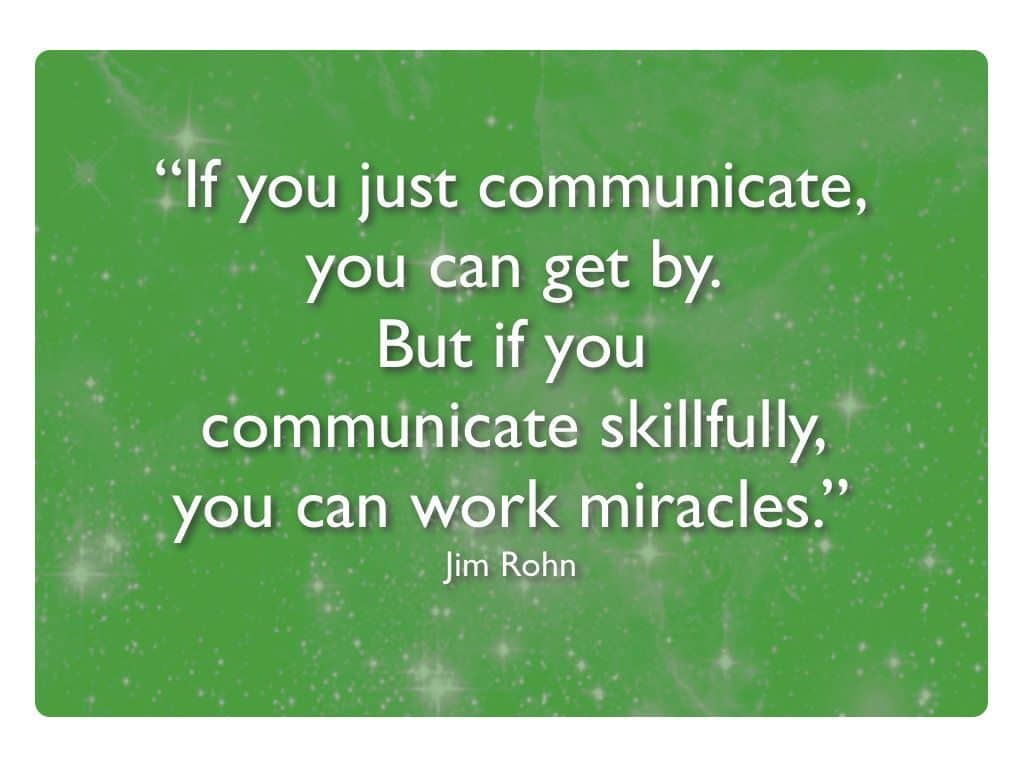
(Source: Pinterest.ch / Kelli McKinney)
Human beings do not always have a ready “if-then” response setup for a reaction. They will need a general level of awareness to make an informed decision and make them likely to buy.
There will often come times in their day where they will let their guard down.
Persuasion Marketing aims to catch them in these moments, perhaps even trigger them and make them impulsive (enough) to get your marketing message across.
Since buying decisions involve money, they are largely sub-conscious decisions.
People buy with emotions first and then justify it with logic.
So you need to use these psychological persuasion marketing techniques. Persuasion marketing techniques are an application of these psychological selling principles.
If you are selling to human beings, you will need persuasion marketing.
Throughout this article:
- You will learn about the elements that make up your persuasive marketing strategy.
- You will learn and understand the principles behind persuasion marketing techniques i.e. the theories to help persuade your online visitors and users.
- You will learn the exact techniques of persuasion marketing. This is a list of multidisciplinary techniques designed to help get the most sales out of your online assets.
The top 5 elements to consider for persuasive marketing
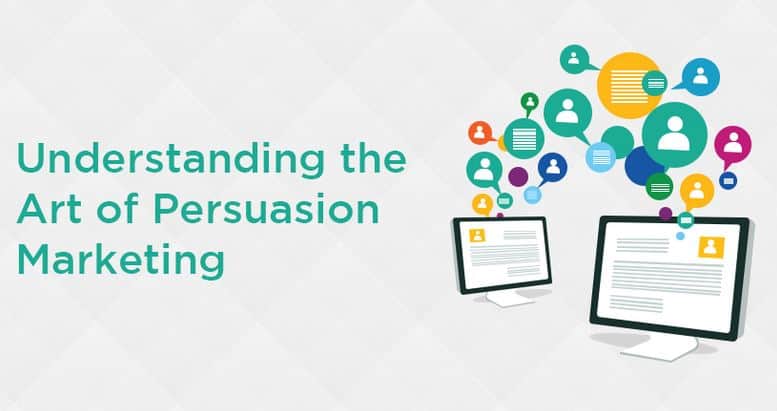
(Source – Medium / Motion Cue)
These elements are part of every persuasive marketing strategy. They add that extra something that’s been missing from your campaigns.
These are the differences between what your average campaigns (that focus heavily on outbound marketing) and the high-converting campaigns that rely on content.
Without incorporating these elements in your content marketing campaigns, you might have to spend more on outreach/interruption marketing campaigns.
These are measures you can take to strengthen the content side of your inbound campaigns. By applying persuasion marketing writing techniques, you can appear more trustworthy and credible to your leads.
This will convince them to share your content and get them likely to buy from you.
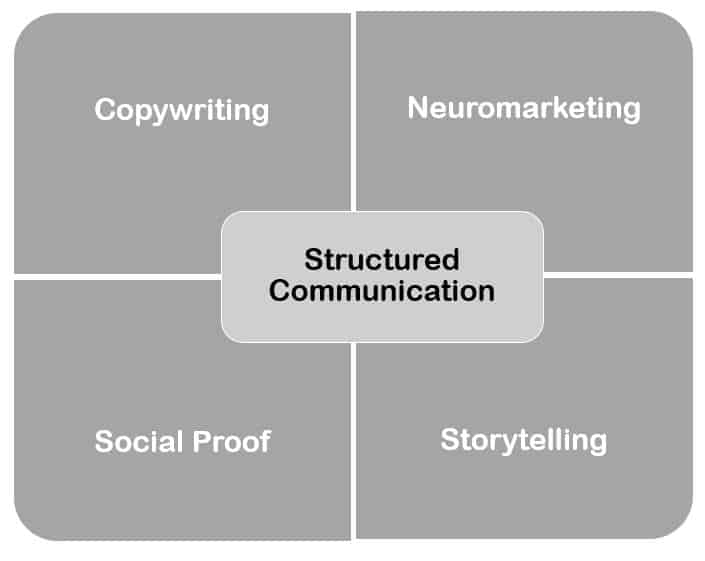
1. Structured Communication
Ever heard of “buyer’s impulse curve”? The idea of structured communication is to plan the sequence of messages delivered to your leads.
The focus of this plan is to ignite their impulses to buy and persuade them across the line until they finish the transaction.
This means, unless it’s a landing page, you should not attempt to sell anything to them. Instead, use your content to gradually increase their buying impulses and lead them to a landing page or a buying page.
2. Storytelling
The way you narrate a story also matters. The same story may have been told several times, but which one succeeds the most depends on what part of them appeals to viewers’ emotional subconscious responses.
These responses will begin to guide (or even override) their analytical faculties and render them likely to buy.
A good brand story includes all 5 elements:
- A hero (the prospective customer or your brand)
- A villain (their fear of loss or fear of stagnancy or consequences of saying no)
- The passion that drives the hero into a moment of awareness
- Transforms the hero into someone stronger (as a virtue of buying from your brand).
Taking you away from the realm of sales, a good movie
- invokes empathy for the hero
- helps identify and be familiar with his/her situation
- makes us feel affectionate toward him/her
- drags us so deep into the story that we want to the hero to be triumphant
An effective brand story helps prospective customers feel the same about you. Use it for your “about” page.
An effective customer story helps them feel all these emotions for themselves. Use it to add details to your customer persona and target them more precisely.
3. Copywriting
A copywriter tests different words/phrases, and headings/subhead combos to see which one persuades a particular audience the most.
He/she will test different word combos and gain inputs from his/her own tests as well as the knowledge of the right words for different psychological triggers.
From a persuasion marketing point-of-view, a good sales copy acts as a virtual (verbal) salesperson. Additional resources are usually avoided as the copy is supposed to address most concerns.
4. Neuromarketing
This relates to the use of psychological cues to “prime” the online visitors with the help of visual cues. These cues help trigger certain moods to push them across the “buyer’s impulse curve”.
For example, if you have a website that sells baby products, you can prime the visitors with pastel-colored, floral imagery, and specific words that facilitate purchases.
5. Social Proof
All human beings have a strong sense of belonging. You can also use this psychological trigger by sharing stats and testimonials of other users who bought the product/service.
Structured testimonials are the easiest way to showcase social proof. Visitors usually tend to not trust testimonials, unless they’re presented in an authentic manner.
Visitors would think that the website owner randomly threw together some words to persuade them. Testimonials tend to look biased (or even fake) if they:
- are overly formal
- do not have a picture of the person
- do not have the name of the person
- do not show how the person is associated with the product/service being sold
- do not have a source of the profile – if it’s a B2B sale (i.e. the name of the organization where the person works and his/her designation in that company)
Simple persuasive strategies
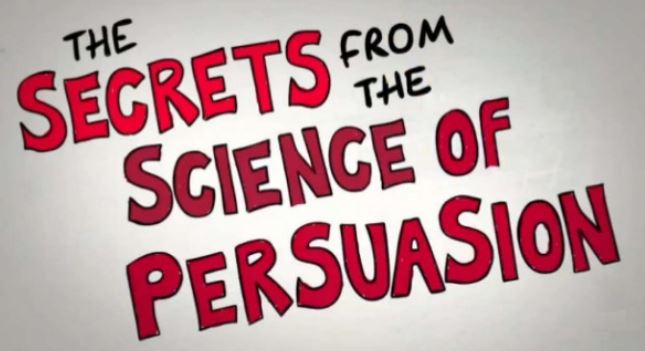
(Source: SlideShare / John Nickels)
When a guy is confessing his love to a girl, do chocolates and flowers always work?
Some of you might agree. Most of you would say that’s outdated.
Similarly, in the world of persuasion marketing, there are a lot of old principles and misconceptions. In this section, we’ll see some of the very basic principles that are at the heart of online persuasion marketing.
Almost all marketers and copywriters have used them in one way or the other. So, read along and find out if you can recall a particular example of each of these principles.
1. Anticipation
Wonder how Apple has made its September launch a globally recognized marquee event? They send out incredibly persuasive invites to folks in media. The media professionals retweet and share about it.
Thanks to the quality of products and user experience they offer, Apple acquires a strong position in the market.
Their announcement of the event may be similar every year, but it still builds massive amounts of anticipation in public.
Wouldn’t it be great if you could have that for your brand?
I have yet another example, and this one comes from the magical world of television: Game of Thrones.
We all know how successful the show is. Every telecast draws in millions of viewers from across the globe.
Of course, George R.R. Martin, David Benioff, and D.B. Weiss have created a magnum opus that is well on its way to becoming a cult of its own.
But what’s impressive to me is the online machinery behind the show. There are forums that devoted GoT fans visit to talk about the show.
There are Facebook groups and pages dedicated to the show. Not to forget, I follow at least three different exclusive GoT accounts on Instagram.
Dig a little deeper and you will find an online subculture where people express themselves using memes from the show. I am talking Reddit and the Forums.
Not to forget the underbelly of crazy fan theories about each character. The show boasts of some of the most powerful fictional characters entwined with the most complicated plots and storylines.
The houses, their values, their words, and their sigils – make people take sides – they give the fans a sense of belonging!
All the online machinery operates during the off-season while the show is still in making. It keeps people hooked on to the show and draws them even more towards it.
The secret sauce behind Apple’s launches and HBO’s show is Anticipation!
So next time you launch a new online product, be it a lead magnet, blog post, webinar, or anything else, build anticipation about it on social media.
Also, consider PR articles that help build a vague image of what’s to come.
This will get your target audience excited and once the launch happens, they will be drawn to it like bees to a new blossom!
2. Reciprocity
One of the simplest and most powerful psychological triggers that motivate people to take action is Reciprocity.
It ain’t easy though. There are a lot of moving parts. For example, it starts with a free lead magnet. If they like it, they would want to check out more content.
Eventually, your marketing funnel draws them towards your full package. It takes some time, but they are eventually likely to buy and become your customer.
What happens when your audience consumes the lead magnet but for some reason doesn’t buy the full package?
This is pretty normal. Not everyone may be likelyto buy when you are ready to sell.
What will you do then?
The simple answer is – you will give more free stuff!
Now, this may sound radical at first, but hear me out.
Since you already have their email address, you can use email marketing to pitch more high-quality content. Use social media to remarket them.
Use the principles of scarcity to persuade those who are waiting for something better.
Use discounts or installments for those who might not be able to pay you all the money upfront.
Reciprocity works on the simple principle that people feel indebted to those who give them free content.
Yes, it may take time to work, but with a smart marketing funnel, persuading even the most stubborn of leads is easy.
3. Likeability
We all know how likeability influences our own decisions. If your friend asks you to lend money, you might be hesitant.
But if it’s boyfriend and girlfriend, you might actually find it hard to resist.
So, to make your brand more likable, look at your online presence – Are you giving out any signals that make you less likable? If so, how soon can you remove such content?
Can you create content that wins the heart of your audiences and renders them likely to buy? What would it take for you to create such content?
4. Emotions
While likeability is easy to achieve for B2C brands, it becomes almost impossible to make B2B users “like” you.
Even if they like you, their purchase decision equation involves more than just likeability – and a number of stakeholders.
A simple trick you can apply here: Share the story of your business that came through with a lot of struggle and succeeded despite all odds.
All senior management and founders identify more closely with struggles because it is a part of their own stories as well. They can relate better to it.
Find a similar struggle in your story. Then find your way to showcase it so that viewers feel good about themselves. This should take you on your way to B2B stardom.
This doesn’t mean B2C brands can’t use emotions.
Have a look at Absolut India’s recent “We are born colorless” campaign ad. They have posted it on their Instagram page.
When I first saw their ad, I was taken aback. It was the most brilliant campaign I had seen in a long, long time. As a result, the next time I drink Vodka, I am asking for Absolut.
The message of their ad is simple. We may be different in many ways. But color is how we distinguish adults, kids don’t discriminate based on color.
They learn discrimination by seeing it in the world of adults.
This taps into the feeling of “unity” and triggers a sense of belonging. This is how Absolut has associated itself with an idea of unity and benevolence.
5. Controversies
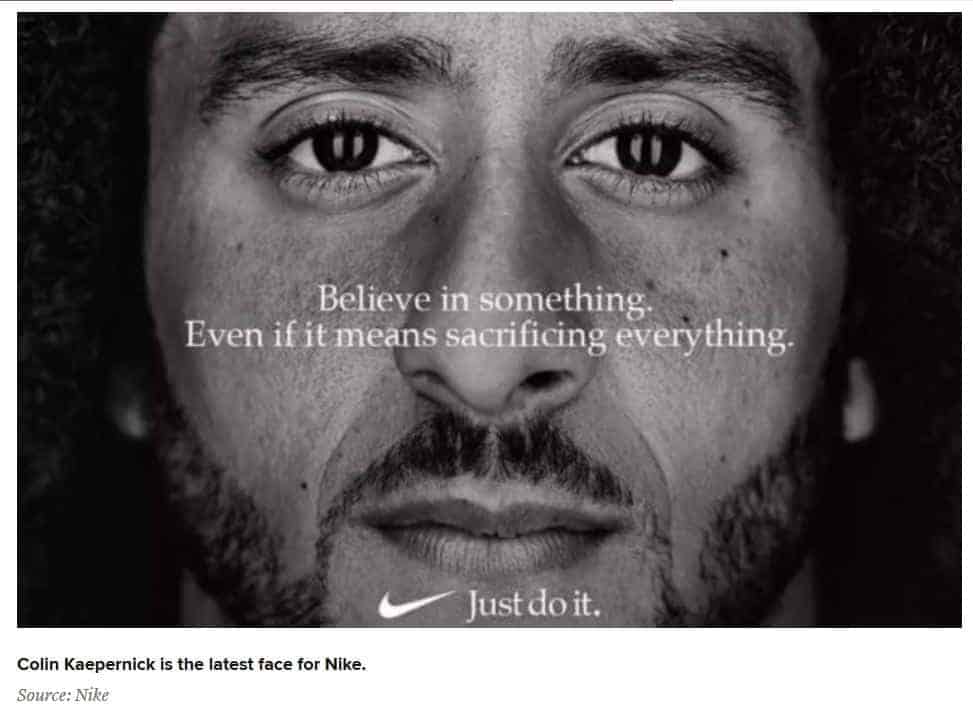
(Source: Nike Instagram Account)
When Nike used Colin Kaepernick to send out a bold message, their campaign did receive initial flak for using such a polarizing figure to market their brand.
The net effect, however, was positive.
Here are some stats to prove it:
- After the initial setback, Nike’s stock price surged to a record high of $83.90 in the days following the launch of the campaign. And the effect has not subsided. Nike’s stock price (as of writing this article) is stationed well above $87. In fact, at its highest, it came close to touching $90 in April 2019.
- Nike’s Instagram followers grew by about 170,000 in the weeks following the campaign release.
- The campaign went viral drawing praise from celebrities. Of course, some skeptics would say “But that was Nike”. What most of these skeptics ignore is it was also an example of “unpaid influencer marketing”. Imagine what a single repost like that from a celebrity can do for your brand!
Yes, controversial campaigns are tricky to get it right. Just ask all the brands who failed at it.
And yet, they are one of the best ways to persuade customers to “like” you. If done right, you are opening a whole new pool of potential customers for you – just by unlocking their “likeability” impulse.
So, how did Nike get it right while so many other brands got sucked into the controversy?
The core theory behind Nike’s success with the Kaepernick campaign is the overall message was, more than anything, very inspirational.
Pursuing any kind of sport is difficult, be it for a rookie, a novice, an enthusiast, or a professional. Motivation then becomes a daily need and not just an occasional dose.
And due to being inspirational, it also spoke directly to Nike’s audience – sports enthusiasts and professionals.
Creating your own controversial campaign requires deep industry insight and an adept hand at PR. Get it right and get your brand soaring beyond just immediate sales numbers.
Get it wrong and you could be staring at potentially several years of PR recovery.
However you do, make sure you do a beta test run for the ad among a sizeable number of alpha testers. These could be your own employees or even people hired to be your testers.
The format of the test would be a questionnaire to assess reactions after seeing the ad.
Do not overcommit and publish the ad without analyzing the reactions of these testers.
You want to first see the sentiments your controversial ad arouses and then do a strategic assessment of how it could affect your brand.
If you conduct a behavioral test like this that involves external participants (other than your employees), you would then need an ironclad NDA (among other measures) to prevent them from resharing what they see.
You don’t want the ad to get out before your brand is ready to release it IF you are ready to release it.
6. Logic
Often, when all other modes of persuasion marketing fail, logic comes to your rescue. Logic is a not soft persuasion tactic, though.
You will use it in cases where your audience has already seen a lot of marketing material.
Chances are they are not getting persuaded by other tactics because they have other options and the product/service is a commonly used entity.
You will then need hard facts to differentiate your product from that of your competitors.
For example, get yourself endorsed by industry authorities or build a feature into your offering that they find it hard to say no to.
To trigger logic as a persuasion marketing tactic, make sure you express the advantage in a simple manner. Jargon kills logic, in most cases.
To may work still work though – if you use a technical term as the key differentiator. For example, a new technology that no one else in your industry is using it.
You might have seen logic being used often in the marketing mix for daily-use home products like detergents and appliances like water purifiers.
Because they have a wider audience who are generally industry-outsiders, they get attracted when they see a regular-use product is doing something new and extraordinary.
This is an example of a case where jargon may actually help getting your logic across to your audience.
7. Reaffirm Beliefs
Want to be friends with your audience? Want to make your potential customers feel like you could be their partner in crime?
Get on their side and encourage their beliefs. If they hate something, you also project hate (or another strong negative emotion) toward that entity.
If they like something, find ways to show that you share the same love.
Communication is all about having something in common, which is why being on the same page during a negotiation is SO important for it to go well.
By reaffirming their beliefs, you make it easy for your marketing communication to have a positive effect. They see you as one of their own.
When they see your product and services, they will find reasons to include your product/service in their daily life and be likely to buy.
8. Break Myths
Quite often, potential customers might have certain unfounded objections about your product/service, or even the industry in general.
These are usually based on hearsay or rumors. To get yourself on their side, help them break these myths.
Once you help them clear your myths, they are going to remember you when they make the next purchase.
Pitch your services after clearing your myth and make it easier for them to take a decision in your favor.
For example, in middle-class cities and rural towns in India, selling credit cards and insurance policies is very tough. Firstly, these residents are focused on saving money.
So, it’s very likely that the moment you ask them to invest in your policy or buy your credit card, they would scoff off or laugh at you.
To make these interactions easier, start by busting some myths like credit cards are expensive.
Tell them the truth that credit cards are just another way to borrow money and they will get expensive only if you miss due dates.
So now that you know the incredible power of busting myths of your customers, which myths are you going to bust next for your customers?
9. Show Reality
In some industries, the audience is hard to sell to because they’re often resistant to change. Some examples include weight loss, self-improvement, or any kind of physical/spiritual transformation products.
Sometimes, the audience may not be able to see the problem until it is explicitly pointed out to them.
This means the content your marketing department produces must be an eye-opener and delivered in an appropriate manner.
Once you open their eyes, you get to take them on a journey of self-transformation. It ensures persuasion and brand loyalty at the same time.
Be very careful that the tone of the content shouldn’t be very negative. It should be positive and grounded in reality at the same time.
Use logic to convey reviews and survey results to convince them. You can also use humor.
10. Proofs and Results
Does your product work? How well does it work?
These questions might seem really simple but they are also very powerful ways to discover your own strengths as a product.
If you want to make your claims more credible, include a solid proof with the help of one or more of the following tools:
- Exact numerical stats showing results from existing customers and internal tests.
- Testimonials from trustworthy clients. Ensure the testimonials capture the person’s full name, organization name, his/her role, and a professional headshot.
- Case studies detailing how the (improved) end result was achieved.
- Progress charts (while your product was being used)
- Client KPIs (Ask them before you use them for marketing!).
Persuasion marketing is often very simple – like answering basic questions and showing the results.
Ignoring small things leads you all the way to an “empty” campaign with tall claims and nothing much to show for it.
11. Endorsements
I always get asked this question:
How do small businesses with very few (or zero) customers prove their worth to their target audience?
I ask them this question in return:
Have you seen how Nike does things?
Nike relies on celebrities like Colin Kaepernick, Serena Williams, Usain Bolt, and until a while back, Roger Federer.
The Swiss Tennis star switched clothing sponsor to UniQlo after they offered him a whopping $30 Million USD deal (Nike only offered $12 Million USD).
UniQlo isn’t as big as Nike.
But now you know who UniQlo is, thanks to an endorsement from arguably one of the greatest tennis players of all time.
That’s the power of celebrity endorsements!

Do you follow any beauty or fitness bloggers on Facebook and Instagram?
They regularly share products from brands; they’re influencers i.e. mini-celebrities.
People love to believe in numbers and concrete results. They also believe other experts and celebrities in the industry.
You don’t need megastars to endorse you. This is a misconception. You need to find a person/account who is the right fit for your target audience.
Finding the right influencers to endorse your product/service often works very well for most new brands.
Are you struggling to find people to promote you?
Scour through your emails and social media. Write smart outreach emails to showcase them your product.
Maybe even offer an extended free trial in exchange for promoting your product.
You can also run an affiliate program and ask your customers to promote you in exchange for a small percentage of your profits from each sale.
12. Stories
Tell stories to sell more – it’s simple as that. Well… not quite so!
What do you think of when someone says you have to share stories to persuade people?
You might think it’s hard work. But you figure that since so many people recommend storytelling – there must be some truth to it.
So you start writing up stories. You think of a protagonist, his/her goal, an antagonist, add some drama, and so on.
It’s no fun if you are not into creative writing!
Don’t go about it without first giving thought to HOW you are going to utilize your story.
You have so many online assets and each one requires a different type of content. And stories won’t really be useful on all of them.
Some of the more creative ways to use stories are:
- Short stories (involving characters in your niche) shared through a series of posts on social media. Keep them spaced, one post per week. This will keep them guessing and they’ll be engaged. This will result in growth in social media followers in short term and social sales over the longer term.
- Run contests and giveaways and ask participants to guess the ending of a story and share the original post to enter the contest. Make them choose between two easy options. Since most people simply scroll through social media (often absent-mindedly), this will invite immediate engagement. Moreover, as users share about your brand, they invite their friends to look at and join your contests. You get a whole pool of influencers at the cost of running a simple contest.
You could also use stories to inspire people to overcome objections or other psychological blocks.
Always remember them: Keep your stories simple.
Trying to do too much through your stories always leads to lousy stories; they repel users rather than engage them in an immersive experience.
13. Authority
Asserting authority is a tricky slope. Do it wrong, and you come off as boastful and even condescending at times.
Do it at the right moment, you have yourself a persuasion marketing goldmine!
There are certain products that don’t need an authority figure to sell. But digital products like courses, transformations, personality enhancement literature, and media – all of these are better sold by an authority figure.
Basically, if they expect a huge transformation or they have to pay more than 30% of their salary to avail of the product/service, they will ask for your credentials.
These are the few examples where proving that you have authority is one of the biggest persuaders.
You can project your authority (and not sound boastful) in the following ways:
- Share the EXACT number of people whose life has been positively transformed after using your product. (Using precise numbers instead of estimates is another neat credibility trick!)
- Share how long were they able to sustain the growth after they were done with your product/service/course. If your audience has been through many such courses, they would still be skeptical. They might think that your course teaches short-term growth. So go ahead – share long term growth numbers as well. However, doing so without concrete evidence may end up portraying you as a shady business.
- Find and ask for testimonials that focus specifically on your process e. on the way you do things. Your mentees are going to spend a long time with you, they would want to know if you can be gentle and strict as and when needed.
- Gather and showcase trust badges from third-party review sites like TrustPilot and other industry-specific media endorsements.
Never boast authority while responding to customer queries on social media.
14. Scarcity
The way scarcity works is – it lets them know that not buying is not an option. It triggers their FOMO (Fear Of Missing Out) instinct and makes them think fast on making their decision.
As a result, they stop procrastinating on the decision.
If they are not ready to buy, they will back off right away.
If they are less likely to buy, you are giving them a negative consequence of taking too long i.e. product would be sold out.
If they are just on the fence, this pushes them across the fence.
Instead of “waiting for the right time” to purchase, such leads would just “go and grab it”, resulting in an instant sale – just because they thought that they would miss out on your product.
So make your product appear scarce (even if it actually isn’t) and see how they flock up to buy your product/service/course.
But don’t overdo scarcity, or your audience may get complacent and think your scarcity is fake.
Here are some ways to introduce scarcity as a persuasion trigger in your marketing campaigns:
- Limited-time and/or limited-edition products
- Seasonal or time-bound products.
- Limited-quantity products (only for first X number of buyers)
15. Urgency
I consider Urgency a messy cousin of Scarcity, but it is still equally (or at times more) powerful than Scarcity.
Most marketers think Urgency and Scarcity are one and the same. But they are actually two sides of the same coin – the coin being “triggering of the customer’s FOMO”.
‘Scarcity’ places limits on how much product is sold and ‘Urgency’ controls how long it is sold for.
To execute a marketing strategy based on Urgency, add a timer on your landing page.
This won’t be enough though. Your Urgency strategy would be more effective if you added a component of fear by telling them they would lose the benefit once the counter expires.
For example, if you sell a product that helps your customers grow wealth, you can highlight one of the two facts
- If they don’t nab the opportunity now, they might stay broke.
- If they miss out on this sale now, they would keep experiencing the same lack-of-money pains as they do now.
Implementing advanced persuasion marketing techniques on your website

(Source: MDG Advertising)
What is the kind of website you host? Does it apply to content marketing features or simply sell stuff like an e-commerce store?
An eCommerce store would need high-intensity persuasion marketing techniques since they have a lot more stuff to sell.
In this section, I have shared several exact persuasion marketing techniques to apply directly.
Usually, marketers who do not consider psychology as an important tool for marketing, end up going against human psychology. They ended up losing sales.
I do want to make sure that that doesn’t happen with you. This is strong advice. Better be ready to implement it right away as you read them.
If you are selling an individual product (digital or physical), some of these may be more useful to you than others.
Apply Repetition
The same brand books multiple ad slots (at least once during each commercial break) when a popular sporting event is a telecast LIVE.
If you are in India, you would have noticed the ads during IPL (Indian Premier League). Outside of India, advertisers flock to Football events like EPL (English Premier League).
And we see the same repetition in action when we see multiple hoardings of the same brand alongside the highway.
Repetition is a magically simple yet magnificently powerful weapon. But how does it work?
Repetition works because it employs the “illusion of truth” principle from Persuasion Marketing Psychology.
Various studies into this principle conclude this:
“The more we hear something, the more familiar it becomes to our mind. Because it is more familiar, it also requires less time and effort to process, making it the least cost solution.
Because we are wired to choose the least effort option, a repetitive concept seems truer to us than a first-time concept”
But that does not mean that the more you repeat your message, the more persuasive it gets. It’s not so simple.
Studies have also found that there is a threshold to the number of repetitions acceptable to our mind. And that repetition as a persuasion marketing tool works when the audience is least attentive.
From the fantastic Illusion of Truth article on PsyBlog, here are some principles for applying Repetition effectively:
- Make sure your argument is strong i.e. the benefit you choose to repeat is what the potential customers are actually looking for.
- Repeat your point between 3 and 5 times in a given duration. Anything less than 3 times may not be registered as truth, anything more than 5 times may be labeled as irritating. Over-repetition tends to breed contempt.
- When people are not paying attention, the effect of Repetition is stronger.
- A perfectly-timed weak argument may still be rejected when people are paying attention.
Repetition is more effective in online marketing, where readers already have very low attention spans and tend to skim through content instead of reading it in full. In an online context, repetition makes the benefits stick.
You would be losing out on a very low-cost persuasion marketing technique if you underestimated Repetition.
Write Persuasive Landing Page Copy
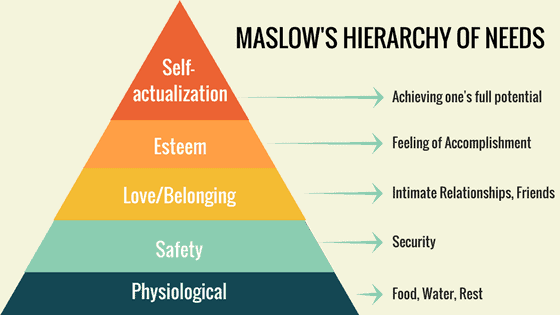
(Source: Coachilla.co)
You might not have done an expensive copywriting course from A-list copywriter, you can still write a high-converting landing page.
An effective landing page anticipates all questions a customer might ask and then answers them.
To do so, take a cue from Abraham Maslow and use his good-ol’ Hierarchy of Needs as your North Star while anticipating audience needs.
The method also involves a smart use-case of Google Keyword Planner.
Here are the succinct steps of writing persuasive copy for a high-converting landing page:
1. Use Maslow’s Hierarchy of Needs pyramid to figure out which need does your product fulfill.
2. Highlight the pain of not using your product (and subsequently of the underlying need not getting fulfilled) using words that reflect an appropriate conversational tone.
3. Find questions your audience might ask using Google Keyword Planner. For this step, use your (or a competitor’s landing page) as the search key and restrict the keyword search to include keywords containing the W/H question-words only.
The W/H question-words are: what, when, why, where, how, how much, and how many.
4. Answer those questions by using your product’s features. For example, if the question is “how to clean your product”, highlight why your product is easy-to-maintain.
If the question is about the time saved, mention how much time will the user be able to save if they used your product. Also, mention the average time all your users have been able to save – this adds the social proof trigger (i.e. the community/belongingness feeling).
Infuse Benefits to Persuade Users
So many products (especially tech products) are sold with a strong focus on features.
The people who buy these tech appliances and gadgets may or may not be well-versed with the technical terms. Their marketing brochures will still use a jargon-soaked copy.
As a result, when potential buyers see the brochure or see the online product description, they can’t relate it.
Even with your brand appeal being seductive, you may not always convince the customer to buy.
So how do you create a list of benefits? What’s the difference between features and benefits anyway?
As Belle Beth Cooper succinctly puts it in this article:
“Features are the things that your product can do. Benefits are things your customer can do with your product”
She cites some wonderful examples too.
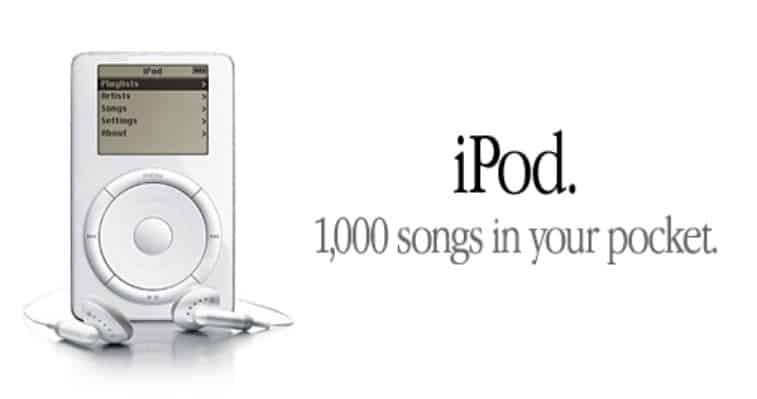
For example, Apple’s iPod was launched with a tagline “1,000 songs in your pocket”. It didn’t say that it had X GB of memory.
The amount of memory the device has is its feature, and the number of songs a customer can store in it is a benefit that the customer gets for buying that device.
Here’s Evernote doing the same with its uber-successful note-taking app.
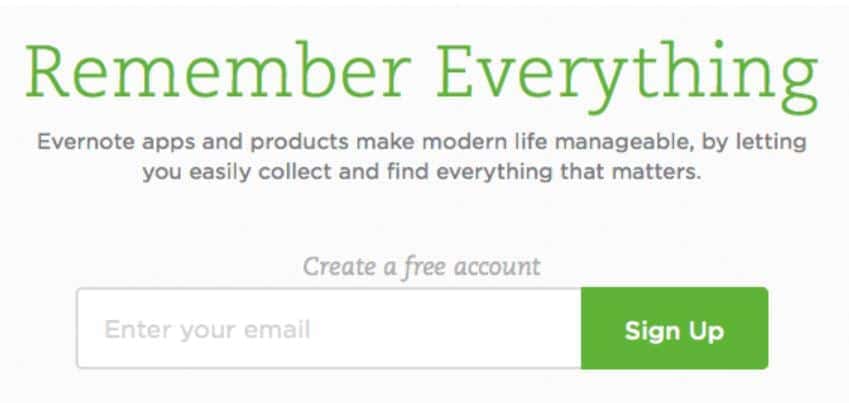
“Take unlimited notes from any device” is the feature of the app, but “Remember everything” is what the customer gets as a benefit from downloading the app.
Here is the last one: LinkedIn
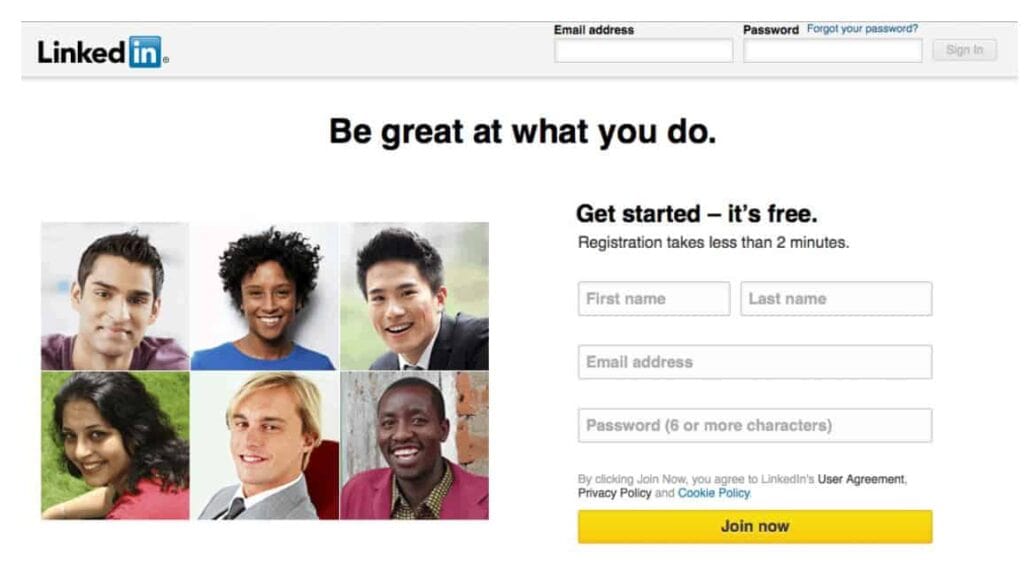
“Create a profile for professional networking” is what customers do on LinkedIn but “Be great at what you do” is a feeling that shows how their life can change as they use LinkedIn.
This is an even better tagline than the first two because it directly talks to the customer.
Wondering if there’s a process behind these taglines?
Wanna know how you can be known among these brands by creating brand taglines like them?
Here are simple steps you need to follow to infuse benefits into your copy:
- List your product features.
For the purpose of our example, let’s say one of the features is “power saving of up to 40%” on the brand new AC.
- Find what benefit can the customer get from the feature.
For the same example mentioned above, an appropriate benefit will be “power bill reduction by up to 40%”.
- Describe how these benefits make customers’ lives easier
For our brand new AC product, it will be “Reduce your power bill by up to 40%” or simply “Pay 40% less on your power bill”.
Unearth Customers’ Real-life Problems Through Forum Research
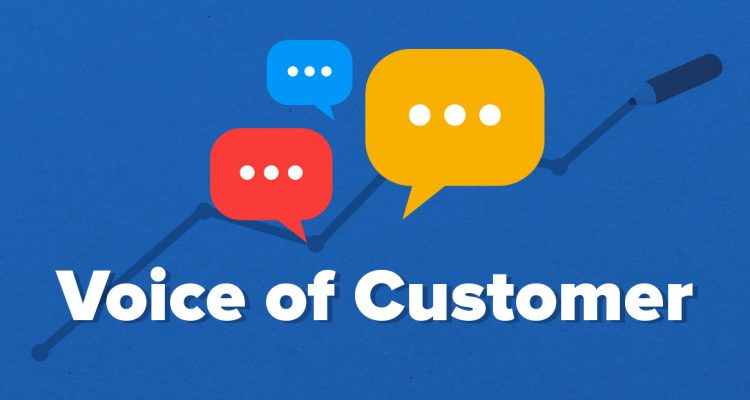
(Source: SuperOffice.com)
The best way to persuade your customer is to know them. Once you know them well enough, finding persuasion marketing techniques that work for them becomes easier.
How can small businesses (or early-stage brands) with limited customer data build solid, fact-backed customer profile without investing in research reports?
Online forums exist for almost kinds of purchases. While not everyone would want to use them, chances are those who do use it will maintain a detailed profile with a list of their interests.
These forum user profiles are a goldmine for your customer research.
Here is a short step-by-step process to find forums to start creating or to enrich your customer persona:
- Find forums where people talk about purchasing your products (or products in your niche)
Use words like “should I buy”, “just bought”, “how to buy”, “product review” and so on. Use double quotes around these phrases to limit the search results.
Find more such phrases to use with your search process.
Combine them with a special Google search operator “inurl: forum” to limit the searches to forum conversations only.
- Find the longest, most-responded-to, and most-active forum threads.
Scan through them, find their common and uncommon pain points, list them down, and circle those problems which your product/service can solve.
- Click on the most active customer profiles and note down whatever information you can get about them
You can also look for the most unsatisfied users in their forum. The more you read their posts and profiles, the more problems you would able to enlist.
By finding out the most important problems which your product/service can solve, you can market it better from multiple angles with diverse benefits.
Once specific customer profiles interest you, click on their profiles, and find out their location, age, hobbies, interests, and what are their professional roles.
- Refine your research by asking a few important questions
Your customer research is not just about your customer persona. You also want to know how to sell to them better. Look at this list below and find values for these fields.
- What were their choices before buying and how were they different from each other?
- Why they bought the product that they did? Or Which choice won them over and why?
- What did they appreciate about the buying process of this product? Did the product support team answer their questions satisfactorily?
- What life goal or daily purpose does the product help them achieve?
Answer these questions by using your product and your benefits are ready.
- Let your pages reflect the customer research
Once you have gathered all the exhaustive data about your customers, let it percolate down to your marketing documents.
Find the most important, customer-facing sales pages and rewrite to reflect what you just learned.
Last, but not the least, measure the results the new copy gets for you and find opportunities to make it even better.
Connect Directly to Your Buyers’ Subconscious Mind with Sensory Words
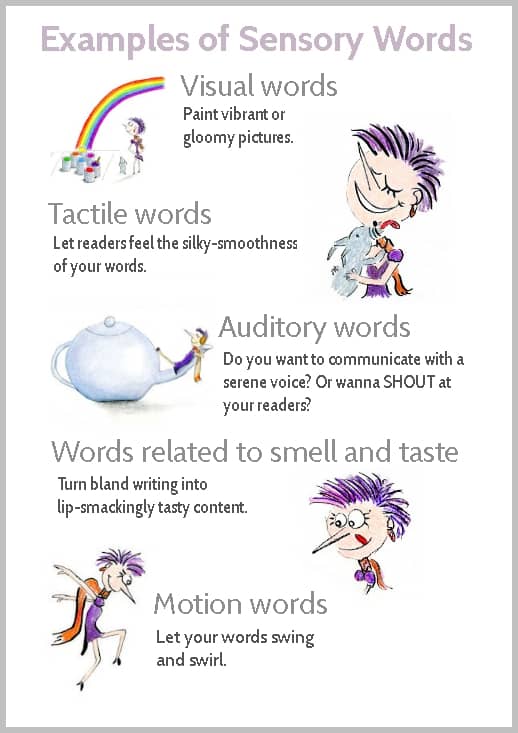
(Source: EnchantingMarketing.com / Henneke Duistermaat)
We now have proof that texture metaphors activate the same parts of the brain that process real sensory information.
In other words, reading words that describe different senses in great detail is as equal to experiencing those feelings in real.
This means that sensory words are processed in the same parts of the brain that process real sensory data.
Basically, you are tricking the buyer’s brain to feel those feelings by using words associated with those feelings.
Persuasion science recommends using these words about the product/service you are selling to make your copy more persuasive.
Here’s how you go about igniting your customer’s senses with your words:
- Use the five senses (Taste, Smell, Hearing, Touch, and Sight) and generate words in a table about your product/service that tingle these senses. Don’t need to populate and fill up each and every column. For reference, you can use this soul-satisfying post from Henneke of Enchanting Marketing. The post mentions 75 such phrases.
- Find words about the context and environment of a product’s use from customer reviews of similar products. Again, don’t need to read each and every review, just find situations that cause problems to users and where your product/service might help.
- Write product copy by using sensory words (from step 1) to solve problems discovered in step 2.
Apply Urgency and Scarcity Without Acting Like a Slimy Salesman
We already talked about using Urgency and Scarcity to boost sales. Many online sellers tend to use them in very shady ways.
They would add a scarcity counter but at the same time, remind them of scarcity multiple times a day – often several times within the hour.
They become so pushy that they end up acting like a slimeball.
I unsubscribed from such an email list just days ago!
The focus on your Scarcity marketing campaign to stop them from procrastinating the purchase, not to push them into purchasing something they might not need.
Here are some ways to not be pushy while applying Urgency and Scarcity:
1. Offer genuine value in exchange for quick action. Does your 50% sale end in 24 hours? Let them know that “Only 1 day left to claim your savings”. This way you link the benefit of claiming the purchase (i.e. savings) to the limited duration (scarcity with “only 1 day”).
2. Offer additional value if they buy early. This gives additional incentive because prospective buyers know that they will lose the benefit if they don’t act fast.
3. Link Urgency with the end state a user will achieve after buying your product. For example, if you are selling a life transformation product like a weight loss plan, tell them that any delay in buying your plan would cause a delay in achieving their own goals.
Add Commitment Triggers Into Your Marketing Workflow
According to Robert Cialdini (the veritable Persuasion scholar and author of widely-referenced books like Pre-Suasion), if your customers have committed to buy from you again, they would want to follow up on that commitment.
This phenomenon bears a striking resemblance to the mere-measurement effect. When you ask for a commitment, you are not trying to influence their behavior.
You are simply measuring their commitment level. If a buyer has given you a commitment (verbal or written), they don’t want to appear as someone who doesn’t follow up on their promises.
This remains true even if the commitment stays private between you two.
Thus, a simple question to measure the commitment levels turns to be an incredibly powerful persuasion marketing tool.
Want to incorporate commitment into your persuasive marketing strategy?
Follow these incredibly simple steps:
1. After the purchase is complete, send an email asking for a review of the purchase. In that email, add a small question: “Would you like to buy from us again?”.
Provide two options for reply: “Yes” and “No”. Let them click any of the two links and track who clicked which link. This is your measuring their commitment.
If your product/service did its job, chances are they would soon return to follow up on their commitment. If they don’t, then follow step 2.
2. If there has been no second sale after certain days (say, a week or more) of the sale, send them a small discount coupon with a minimum-value, like 10% off on a purchase of above $200.
The key to step 2 is to let them know that they made a commitment.
The combination of commitment and a discount should persuade them to make a second purchase from you.
Highlight A Small Negative Point In Your Product Pitch
Want to persuade your potential customers with trust? Add a small, seemingly inconsequential negative point about your product in the description.
For example, if your product is a fashion clothing product, you can enlist its advantages like comfortable, all-season wear, and available in multiple sizes.
The one small disadvantage that could be highlighted is that the product is available in limited colors.
The sequence of listing these features would be:
- ultra-comfortable
- all-season wear
- available in only 2 colors
- available in multiple sizes
In a customized image, you can highlight the positive facts in green and the negative (third) fact in red.
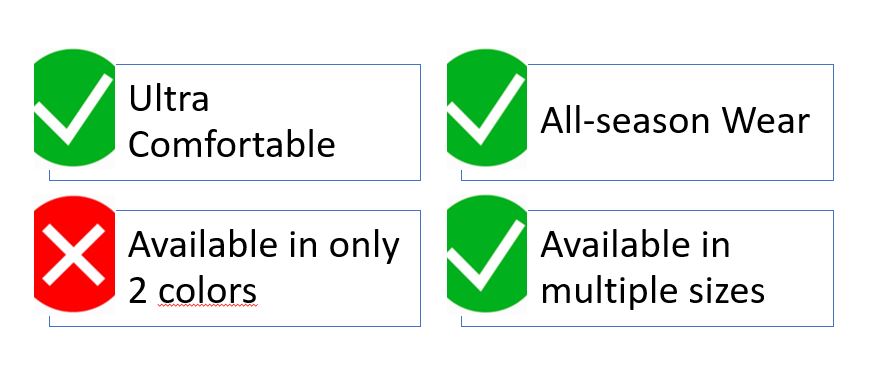
By the time users read the disadvantage, they already know about TWO positive points. The one negative point doesn’t take away the positive effect of two advantages; it only makes your product more real.
Humans have an innate human need to connect with other human beings who are not as perfect and they have a sense of vulnerability about them.
So when they read the fourth point (the advantage), it sticks out even more. At a very low level, it translates to something like “3 advantages and 1 not-so-significant disadvantage”.
If I am trying to give it a mathematical score, it would be 2.5.
As a shopper, the unavailability in more colors doesn’t matter much. I would still be persuaded to buy it even if the product choices do not cover my original color preference.
The only way a buyer would be able to resist this kind of strong persuasion marketing is when they have already spent a considerable amount of time looking for a specific color.
If I am looking for a perfect combination and I have looked at 3 different websites, then I am not going to buy from a 4th website that does not offer my favorite color.
Empower Your Landing Pages
Whether you write landing pages or sales emails, you have to keep the language simple.
Keeping the language simple while still being persuasive involves a lot of craft with your words.
Without hiring a copywriter, how can you ensure your copy has those absolutely important ultra persuasive words?
The skill level of any marketer may not be the same as that of an experienced copywriter. There are certain words you can use to ensure your potential buyers’ brains light up when they read your copy.
These are power words that make persuasion through text simpler.
Here are those words:
- YOU – Addressing the readers directly helps grab their attention and it makes them feel important at the same time. This increases the persuasion power of your landing page and email copy. Many email providers (including Engagebay) provide the ability to add a user’s first name and other personalized customizations to your emails. You can use the first name in emails as well.
- FREE – Several tests have proven how powerful the word FREE is. If users are given a choice between very very cheap pricing and free, they would choose FREE. This means your page will be able to persuade your customers better if you provided something for free instead of reducing the price to a very low point. You can add free shipping, free returns, or free upgrades. Make sure you don’t overuse the word FREE or it might end up lowering your product’s image.
- BECAUSE – Your customers are often asking the question “why” when they read landing pages and your emails. Your brand needs to provide them a reason to buy. Remember buyers who are ready to buy don’t always read in full; they refer to skim the content. Adding the word BECAUSE puts brakes on their skimming and gives them a reason for them to buy.
- IMAGINE – A research published in the Journal of Consumer Research in 2009 found that if non-owners of an object can touch the object, it increases their perceived ownership of that object. You cannot make your readers touch a product on screen. You can, however, help them imagine this touch. While the sensory words described above are also useful, the word IMAGINE has a more direct effect in empowering their imagination about the product.
- NEW – There is solid evidence that when we see anything new, it lights up our brain’s reward center. So look for ways to emphasize the novelty points of your product/service. You don’t have to go so far as to change your brand’s complete visual identity. If you have changed something in your production process, use the word “NEW” to make your copy more credible.
Glean insights from competitor ads
If you have a decent amount of competitors in your niche, you can borrow their persuasion strategies as well.
By using tools like SEMRush, you can find out which companies are spending the most on PPC ads. Then use these tools to further analyze their individual ads.
If they spend very little on their ads, chances are that you may not have enough ads to analyze.
You also don’t want so many ads with so much data that you spend several days just analyzing your competitor.
Therefore, choose competitors who have moderate ad budgets.
You can scour these ads to find some new persuasive words, benefits, or strategies that you can use in your own copy.
Disrupt Your Readers’ Routine Thought Processes
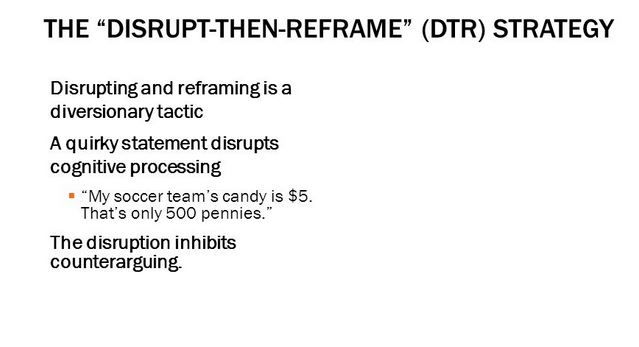
(Source: SlidePlayer.com / Pearson Education)
The web is full of skimming readers. Be it blogs or landing pages, you can’t stop the mental autopilot mode that most readers use to surf the web.
There is one specific persuasion marketing technique though, and it’s called Disrupt-Then-Reframe (DTR).
First demonstrated by Davis and Knowles in 1999, DTR has been successfully proven to work in 14 subsequent studies.
It involves taking an existing idea and twisting it to a small extent and following it by the reframing of the same idea.
For example, the study conducted by Davis and Knowles in 1999 tested two variations of selling statements. The task was door-to-door selling of note cards.
When “$3 for 8 cards” was used, the conversion was 40%.
When “300 pennies for 8 cards, which is a bargain” was used, conversion doubled to 80%.
Converting $3 to 300 pennies was the disruption here. Upon hearing this second selling sentence, anyone would get confused as to why they are selling in pennies instead of dollars.
In the tiny amount of time (while the person is still confused), the idea of a bargain is introduced.
The real magic of DTR here is this: People won’t stop to calculate if the bargain is true while they are still distracted thinking about pennies versus dollars.
You can do something similar in your landing page and email copy too.
Find a popular term that buyers in your niche will understand, then deconstruct it with a negative power word, and reconstruct it by using a different set of words.
Cut the Marketing Jargon Out of Your Copy
Some people communicate in simple words and they’re very effective. Some people use words from a higher vocabulary to emphasize meaning.
If you are a marketer and belong to the second group of people, you need to wake up.
The idea behind using customers’ own words in persuasion marketing is that you have got to give them something that they can share with their friends and peers.
Stop complicating things for your buyers and use less of marketing jargon and more of buyer-oriented language.
Go search for Google and Amazon reviews and reviews of your competitor’s products. Find the most commonly used words and phrases used by buyers in your needs.
This is the language they use to communicate with each other.
Use a Loyalty Program to Build Long Term Customer Loyalty
I get my coffee regularly from a Cafe Coffee Day outlet near my place. Even though they don’t serve the full menu (and I have a plethora of other complaints), I am still using them.
That’s because the CCD app has given me great discounts in the past. Often large meals above $6 have been fully covered with my loyalty points (without paying a single extra penny).
You want your customers to have the same kind of loyalty to you. You want them to overlook those little defects and stay persuaded to keep buying from you.
Loyalty programs are the best ways to ensure repeat business in the B2C sector.
More than saving money, it gives them shopping goals.
For example, “buy from us for a total value of over $500 and get up to 25% discount on your next bill”.
Even if their first bill is below $100, they would buy from you again until the total bill goes above the $500 mark, just to avail that 25% discount from you.
Use “Rhyme As Reason” to Persuade Better

(Source: CambridgeBlog.org)
Buyers aren’t always logical. No matter how hard you try, there will always be psychological biases for you to overcome.
The fluency bias raises its ugly head when the words used in the copy are uncommon in usage, technical in nature, or simply hard to pronounce.
A simple persuasion marketing technique to overcome this fluency bias its to use the rhyming words or phrases.
Rhyming phrases cut this fluency bias by making hard things simpler to absorb in the buyers’ minds.
As a simple example, look at these two sentences.
- What alcohol conceals, sobriety unmasks.
- What alcohol conceals, sobriety reveals.
The first one demonstrates the fluency bias as the word “unmasks” strikes two wrong notes – it’s uncommonly used and it’s hard to pronounce.
The fluency bias is overcome in the second sentence with the word “reveals”.
It not only rhymes with “conceals”, but it’s also smooth on the tongue and readers don’t have to consult a dictionary to understand what it means.
This example was used by Moz co-founder Rand Fishkin in one of his Whiteboard Friday videos.
In the same video, Rand also talks about how the pronounceability of a brand’s name was directly linked to the success of its IPO during an initial couple of weeks of the offering.
Here’s how you can implement the “Rhyme as Reason” persuasive technique in your copy:
1. Find the simplest word for the problem which is solved by your product’s benefit.
2. Find its rhymes on Rhymer.com.
3. Create a sentence that rhymes using the problem word and its rhyming word.
4. Insert the rhyming sentence at the start or end of your copy.
Just don’t overuse it or you risk losing the credibility of your brand. Keep it limited to only the most important benefit of your product/service.
Use Specificity to Your Advantage
Let’s face it – most of your visitors will leave the landing page and only a few of them will actually convert into customers.
There can be many reasons which make them leave. Lack of sufficient details for the buyer should not be one of them.
This may not be a common problem, but it is also a very neglected one even among the big brands.
Here are some questions to ask to help fill your product/service description with relevant details:
- What is the source material of your product/service? Is it locally sourced? Are raw materials organic?
- Where did you build your product? (Locally made products are often popular as they enable buyers to project their national pride)
- Any beneficial details of your production process? (This is a popular technique used by many large FMCG brands).
- Are its benefits measurable?
- Is the size something special that the customer needs to know?
By looking at this list of questions, one might say that it’s more geared towards B2C products.
However, if used smartly, even B2B services can benefit from detailing with these questions.
For example, a copywriting course can be made with a lot of psychological triggers to help sell better.
It can also be a course that has matured with feedback from tens of thousands of students in the past – so you know that it’s not a new course but one that’s been tested by several writers before.
Just make sure you don’t mention the tiny, irrelevant details; it may hurt your brand.
Also, don’t add all the details in one sentence or you risk losing the visitor due to the tardiness of your own web copy.
Consider Adding Mini-stories In Your Persuasive Marketing Strategies
Mini-stories are extremely short stories that are about two paragraphs long. They can use fewer words but not more.
They’re used to build an image of the product in the customers’ lives. They don’t have to be complex or have life lessons; they simply have to highlight the most important benefit of the product.
Make sure the mini-stories you use are:
- Relevant to the product i.e. don’t write mini-stories about the travel destination when you are selling the luggage bags which the user carried with him on that vacation.
- Highlight the brand name.
- Have an element of choice (i.e. the one character showing why he chose your product over others).
- Must not be overly dramatic or funny.
Using product mini-stories gives you an edge over your competitors because most won’t even consider using it.
So say, a visitor is browsing your product and he reads the mini-story. He is already visualizing himself in the position of the central character.
Make him look like the hero in your mini-story and the sale is yours.
Use the Persuasion Sandwich Technique to Boost Conversion
You must have seen some very popular products on Amazon that end the product description with a customer testimonial.
When selling multiple products in bulk, remember that the audience is just skimming the copy.
They are very likely to remember the start and the end of your product descriptions.
This is called the “Persuasion Sandwich” technique. What lies in the middle, matters very little. (I just used “Rhyme as a Reason” on you – haha!)
To make sure the persuasive points that you want to convey to them are inserted right at the beginning and at the end.
There is no fixed type of persuasive points you will use for this technique.
You could start with benefits and end with testimonials, or vice-versa. The order doesn’t matter much.
The effect remains pretty much the same regardless of the type of persuasion point you use on the two ends.
Prime The Users to Subtly Persuade Them

(Source: Usabilla.com)
Timing is a technique that helps market a step into the buyers’ unconscious mind.
It can persuade tension wire without them knowing that some persuasion marketing technique has been applied.
Through Priming, a series of stimuli is used to condition the unconscious mind of the buyer. The stimuli follow a theme that concludes with the main persuading stimulus.
As the user unknowingly processes the initial series of stimuli, his subconscious mind is getting conditioned (i.e. primed) for the main persuasion stimulus.
When the persuasion stimulus strikes, the person is likely to buy without knowing that he was primed into making this decision. He would think the decision is his own.
For example, a study showed that people who were shown (i.e primed with) rude words were more likely to interrupt the interviewer than those who were primed with neutral or polite words.
They might not have realized that was purposefully put into a grumpy mood through priming. But the rude words ended up triggering a grumpy mood that lasted through the interview.
Here are two simple ways in persuasion marketing to directly yet succinctly prime the users into buying:
1. Use “bye-bye” to signal the end of a problem in the buyer’s life. For example, you could say “Say bye-bye to stinky shoes in monsoon with quick-dry, anti-bacterial fabric”. You could also use “good-bye”. The word “bye-bye” is similar sounding to “buy-buy”, while “good-bye” sounds more like “a good buy”. These are called homonym pairs in English – different words but they have the same sound. Use these homonym pairs at the start of your product description or landing page. When the user reaches the CTA, his mind would be conditioned with the word “buy”.
2. Arrange the product display sort order to achieve the relative price priming effect. For example, products placed next to very expensive options are registered in the human mind as cheap by virtue of inherent comparison. A $50 workout tee would appear much cheaper when placed next to a $120 custom hoodie. The user is very likely to buy/choose the $50 tee even though he knows $50 is still too high for a workout tee.
How to be persuasive with your customer – Advanced persuasion techniques for salespeople
When it comes to managing a long-term customer relationship, the most crucial skill any salesperson can have is listening patiently.
You must be aware of how to condition the conversation in order to get the desired result.
Of course, that doesn’t mean pushing the customer. If the customer has clearly indicated that he/she is not interested in what you are selling, don’t waste your time being pushy.
1. Be human and treat the customer like a human being
Think of it this way: To sell to a customer, you have to first understand his/her emotions.
Without actively listening to the customer, you cannot figure out how the user feels about his/her current problem and the product.
You may have a certain script memorized for a specific call, but the user may not stick to that script. For example, the person on the other end may not have been involved in the purchasing decision.
Turns out the person who was involved in making that decision a few months ago has left the client’s company.
Chances are high that after your current caller came in, he/she affected a policy change that meant changes to the subscription that they have for your product.
So now you have to change your script and ask questions about the policy change and what the new policy is. This way you make sure you are alert and responsive to the customer instead of parroting your own script.
Your product might still fit into their plans, or you might be able to suggest your solution that helps them without affecting your product’s subscription.
2. Treat objections as opportunities
Objections presented by the customer can also lead to the right information. If you are attentive and respectful, you can ask the customer about their own perception of this objection.
Questions should be asked to help you gain more context into the objection. Understand their point of view is crucial to helping resolve objections.
Once you understand the context, you will know what the objection is really about and how you can help solve it.
Don’t try to argue with the customer or prove them wrong when an objective is presented. Instead, view it as an opportunity to add value to the relationship by helping the customer solve the core problem behind the objection.
3. Help solve problems by being empathetic
When the customer has mentioned their problem, say you understand before asking any further questions.
This tells then that you are willing to help them solve this problem and it helps them feel neutral about it.
After understanding their problem, mirror their feeling. Let them know that another customer who had a similar problem.
If you don’t have such a customer or you can’t recall any details during the conversation, stick to the protocol of resolution.
Any repeating problem usually has a templated solution. This is the best time to share this template with the customer.
It doesn’t guarantee a solution to the problem, it does help move the conversation forward.
4. Use the right tone and word phrasing to communicate trust
This doesn’t have to take an extraordinary amount of effort.
Sometimes, it’s as simple as not assuming anything about the customer’s problem and giving them time to let them finish speaking.
You also don’t want to directly challenge the customer, lest you come across as rude.
Conclusion
Adding Persuasive techniques to your copy is absolutely essential if you don’t have the budget for a decent copywriter.
This article focused on components of online persuasion, the different persuasion theories, and some really effective persuasive marketing strategies.
Have you tried anything different from these persuasive techniques mentioned in the article? Do share your valuable inputs in the comments section.
EngageBay is a comprehensive Customer Lifecycle Management (CLM) software for growing companies. CLM covers all aspects of customer management across sales, marketing and support.
Check out EngageBay’s offerings – a powerful CRM, Marketing Automation and Customer support software to grow your business.

